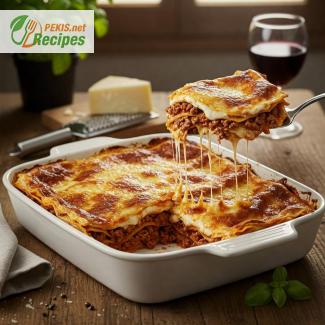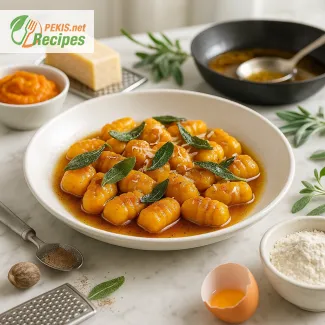
Authentic Italian Lasagna with Homemade Pasta
The Ultimate Comfort Dish with a Rich Bolognese and Velvety Béchamel
Few dishes embody the warmth and tradition of Italian cuisine quite like a perfectly layered lasagna. This classic lasagna Bolognese is an indulgent, slow-cooked masterpiece that showcases the richness of a homemade ragù, the silkiness of freshly rolled pasta sheets, and the delicate creaminess of béchamel sauce. Unlike quick and easy variations, this recipe embraces authentic techniques, ensuring a depth of flavor that transports you straight to the heart of Bologna, Italy—the birthplace of this beloved dish.
When made with fresh pasta, lasagna takes on an entirely new dimension. The thin, delicate layers absorb the savory Bolognese sauce, binding with the velvety béchamel to create a melt-in-your-mouth experience. Unlike dried pasta, which can sometimes become overly firm or chewy, fresh pasta provides a light, yet structured base that elevates every bite.
The Secret to an Authentic Bolognese Sauce
A truly authentic Bolognese sauce isn’t simply a ground meat and tomato mixture. The key lies in slow simmering, allowing the ingredients to meld into a deep, well-balanced sauce. Traditional ragù alla Bolognese is made with a combination of ground beef and pork, cooked gently with a flavorful base of onions, carrots, and celery. Instead of relying solely on tomatoes, the sauce is enriched with milk, white wine, and a touch of tomato paste, creating a delicate balance between acidity and creaminess.
Cooking this sauce over low heat for several hours allows the flavors to develop, resulting in a deep, umami-rich filling that pairs beautifully with freshly made pasta sheets. Unlike store-bought alternatives, this homemade lasagna Bolognese delivers layers of authentic, slow-cooked flavor that is simply irresistible.
Why Fresh Pasta Makes a Difference
Many people believe making fresh pasta at home is a complicated task, but it’s actually a simple process that yields incredible results. Fresh pasta is softer, silkier, and more delicate, ensuring that each layer seamlessly blends with the Bolognese and béchamel sauce.
Using just flour, eggs, and a touch of olive oil, fresh pasta dough is kneaded, rolled, and cut into thin sheets that cook effortlessly in the assembled lasagna. Because fresh pasta doesn’t require pre-cooking, it absorbs the flavors of the sauce while baking, resulting in a tender, well-balanced dish that is superior to using dried lasagna sheets.
The Essential Role of Béchamel Sauce
While some versions of lasagna rely solely on ricotta or mozzarella, traditional lasagna Bolognese is layered with a smooth, creamy béchamel sauce. Made from butter, flour, and milk, this luscious white sauce adds richness and silkiness, complementing the meaty depth of the ragù without overpowering it. The subtle nutmeg seasoning in the béchamel enhances the overall taste, creating a harmonious contrast between creamy, savory, and umami flavors.
This balance between Bolognese, fresh pasta, and béchamel ensures that each bite of lasagna is soft, velvety, and bursting with authentic Italian flavors.
A Dish Best Enjoyed Slowly
One of the most important steps when preparing lasagna Bolognese is allowing it to rest after baking. Fresh out of the oven, the layers are still bubbling, and the structure hasn’t fully set. Allowing the lasagna to sit for at least 15–20 minutes before slicing ensures that the layers remain intact, resulting in beautiful, well-defined portions.
Lasagna isn’t just a meal; it’s an experience. Whether shared at a family gathering, enjoyed as a romantic dinner, or served at a festive holiday table, this dish brings people together through its rich, comforting flavors and unforgettable aroma.
For those seeking the ultimate Italian comfort food, making lasagna Bolognese with fresh pasta is a labor of love that pays off in every perfectly layered, flavor-packed bite.
- Making fresh pasta:
- On a clean surface, create a mound with the flour and make a well in the center.
- Crack the eggs into the well, add olive oil and salt. Gradually incorporate the flour using a fork.
- Knead the dough for about 10 minutes until smooth and elastic. Wrap in plastic and let rest for 30 minutes.
- Roll out the dough into thin sheets (about 1 mm / 0.04 inches) and cut into lasagna-sized rectangles.
- Preparing the Bolognese sauce:
- In a large pan, heat olive oil and butter over medium heat.
- Sauté onion, carrot, and celery for about 5 minutes until softened.
- Add ground beef and pork, cooking until browned.
- Pour in white wine and let it evaporate.
- Stir in tomato paste, peeled tomatoes (crushed), bay leaf, salt, pepper, and nutmeg.
- Reduce heat to low and simmer for 2 hours, stirring occasionally.
- After 1.5 hours, add the milk and continue cooking for the last 30 minutes.
- Preparing the béchamel sauce:
- In a saucepan, melt the butter over medium heat.
- Add the flour and whisk continuously for about 2 minutes.
- Gradually pour in the milk, whisking to avoid lumps.
- Cook until thickened, about 5–7 minutes.
- Season with salt, white pepper, and nutmeg. Remove from heat.
- Assembling the lasagna:
- Preheat the oven to 180°C (350°F).
- In a baking dish, spread a thin layer of béchamel sauce.
- Add a layer of fresh pasta sheets, followed by a layer of Bolognese sauce, béchamel sauce, and Parmesan cheese.
- Repeat the layers, finishing with béchamel and Parmesan cheese on top.
- Bake for 35–40 minutes until golden and bubbling.
- Let rest for 15 minutes before slicing.
Elevating the Classic Lasagna Bolognese Recipe
Small Changes That Make a Big Difference
A traditional lasagna Bolognese is already a rich and satisfying dish, but there are several ways to refine and enhance its flavor, texture, and nutritional value. Whether by adjusting ingredients, improving preparation techniques, or making healthier substitutions, small changes can elevate this beloved recipe to a gourmet experience. From using higher quality ingredients to mastering the perfect layering technique, every detail contributes to a superior lasagna.
The Impact of Ingredient Quality
The quality of ingredients plays a crucial role in achieving an authentic and well-balanced lasagna. Using fresh, high-quality meats, tomatoes, and dairy products will significantly enhance the taste and texture of the dish.
- Meat selection: Instead of just ground beef, try a blend of beef, pork, and veal. This combination provides a richer, more complex flavor and a softer texture.
- Tomatoes: Opt for San Marzano tomatoes instead of regular canned tomatoes. These have a natural sweetness and lower acidity, which improves the overall balance of the Bolognese sauce.
- Cheese: Freshly grated Parmigiano Reggiano offers a nutty depth of flavor, while aged Pecorino Romano can add a touch of sharpness. Avoid pre-grated cheeses, which often contain anti-caking agents that compromise texture and meltability.
Enhancing the Bolognese Sauce
The Bolognese sauce is the heart of the dish, and small refinements can make a noticeable difference in its depth and complexity.
- Slow cooking: The longer the sauce simmers, the more developed and harmonious the flavors become. A minimum of 2 hours is recommended, but simmering for 3–4 hours over low heat yields the best results.
- Deglazing: After browning the meat, deglazing the pan with a splash of white wine or red wine enhances the depth of flavor. White wine adds a light, subtle acidity, while red wine gives the sauce a robust and bold character.
- Adding milk: A small amount of whole milk softens the acidity of the tomatoes and gives the sauce a silky texture. This technique is a traditional Italian secret that many recipes overlook.
Perfecting the Béchamel Sauce
A proper béchamel sauce ensures a smooth, creamy texture without overpowering the dish. Adjustments to this component can fine-tune the lasagna to suit different preferences.
- Butter vs. olive oil: While butter is traditional, using a combination of butter and olive oil can enhance both the flavor and nutritional value.
- Milk alternatives: To make a lighter version, substitute half the milk with vegetable or chicken broth. For a dairy-free béchamel, use oat or almond milk combined with a small amount of starch to maintain creaminess.
- Seasoning: Adding a touch of grated nutmeg, white pepper, and bay leaf during cooking deepens the aroma and prevents the sauce from tasting bland.
The Power of Fresh Pasta
Using fresh pasta instead of dried sheets significantly improves the lasagna’s texture and mouthfeel. Fresh pasta absorbs flavors more efficiently, resulting in a tender, perfectly layered dish.
- Thickness matters: Rolling the pasta too thick can result in a heavy, doughy texture. The ideal thickness is about 1 mm (0.04 inches) to maintain delicate, well-balanced layers.
- No pre-boiling: Unlike dried pasta, fresh pasta does not require pre-cooking, reducing prep time while preserving better flavor absorption during baking.
Common Mistakes to Avoid
Even experienced cooks can make errors that affect the final outcome. Avoiding these pitfalls ensures a perfect lasagna every time.
- Overloading with sauce: Too much Bolognese or béchamel sauce can result in a soggy, unstable structure. A moderate, evenly distributed amount prevents excess moisture from pooling at the bottom.
- Skipping the resting time: Letting the lasagna rest for at least 15–20 minutes after baking allows the layers to set properly, making it easier to slice and serve.
- Using low-quality cheese: Pre-grated cheese contains preservatives and anti-caking agents, which prevent smooth melting. Always grate cheese fresh for a creamier, more authentic result.
Healthier Alternatives Without Compromising Flavor
Lasagna Bolognese is traditionally a rich dish, but with a few smart modifications, it can be made lighter and healthier without losing its signature taste.
- Whole wheat pasta: Switching to whole wheat lasagna sheets increases fiber content and provides more nutrients while maintaining a robust texture.
- Lean meat: Using lean beef or turkey instead of traditional fatty cuts reduces saturated fat without sacrificing taste.
- Vegetable layers: Adding grilled zucchini, eggplant, or spinach between layers enhances the nutritional value while contributing extra depth of flavor.
- Less béchamel, more ricotta: Replacing half the béchamel sauce with fresh ricotta results in a lighter texture while keeping the dish creamy.
Boosting Flavor with Additional Ingredients
Certain enhancements can make lasagna even more flavorful while staying true to its classic roots.
- Mushrooms: Adding finely chopped mushrooms to the Bolognese sauce intensifies the umami profile and provides a meatier texture.
- Anchovy paste: A tiny amount of anchovy paste (1 tsp) enhances depth without adding a fishy taste, similar to how chefs use umami boosters like miso or Worcestershire sauce.
- Fresh herbs: Adding fresh basil or oregano at the end of cooking brings a brighter, fresher taste compared to dried herbs.
Why Homemade Lasagna is Always Better
Making lasagna from scratch ensures control over quality, freshness, and taste. Compared to store-bought or frozen versions, homemade lasagna is:
- Free from preservatives: Processed lasagna often contains additives, stabilizers, and excess sodium, which can dull the natural flavors.
- Customized to taste: Whether adjusting the level of spice, salt, or creaminess, homemade lasagna allows personalized modifications.
- A richer, more satisfying experience: Cooking lasagna from scratch is a rewarding process, resulting in a dish that feels more authentic and homemade.
A few thoughtful adjustments can elevate a traditional lasagna Bolognese from good to outstanding. Whether focusing on ingredient quality, cooking techniques, or healthier alternatives, small refinements make a significant impact on the flavor, texture, and overall experience of this timeless Italian dish.
- Contains: Gluten (wheat flour), dairy (milk, butter, Parmesan cheese), eggs.
- Gluten-free alternative: Use gluten-free flour for pasta and béchamel.
- Dairy-free alternative: Replace milk and butter with plant-based substitutes.
- Egg-free alternative: Use an egg-free pasta recipe (water and flour-based dough).
- Vitamin A: 950 IU (Good for vision and immune system)
- Vitamin C: 7 mg (Boosts immune function)
- Calcium: 220 mg (Supports strong bones)
- Iron: 3.5 mg (Essential for oxygen transport in blood)
- Magnesium: 40 mg (Aids muscle function and metabolism)
- Lycopene: 9 mg (from tomatoes – protects against oxidative stress)
- Beta-carotene: 0.8 mg (from carrots – supports skin health)
- Polyphenols: 4 mg (from olive oil – contributes to heart health)





